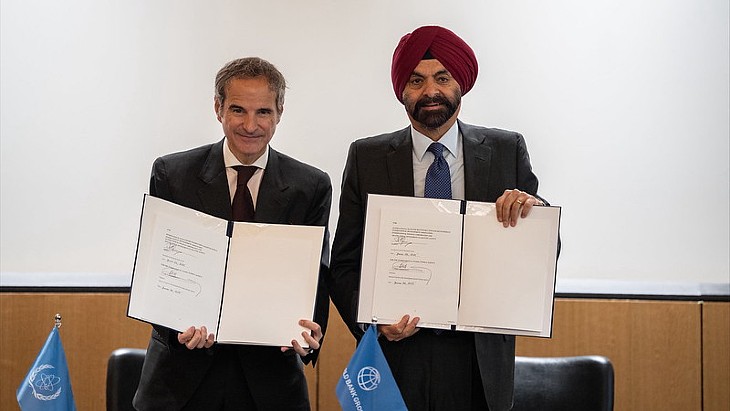New compact particle accelerators could offer game-changing possibilities
.jpg)
TAU's accelerators use laser technology to make electrons "surf" on three-dimensional plasma waves, and accelerate them to high energies. Lasers can create much more intense fields than those found in normal particle accelerators, enabling higher energies to be reached over much shorter distances meaning the machines can be made significantly smaller.
The concept itself is not new: the theoretical concepts of the laser electron accelerator were first published by researchers at UCLA in 1979, but at that time laser technology was not sufficiently advanced to move the concept from theory to practice. This changed in the 1990s, with the development of pulsed lasers - work for which Donna Strickland and Gérard Mourou received the 2018 Nobel Prize for Physics, TAU founder and CEO Manuel Hegelich told World Nuclear News.
"There are two things really that makes this so potentially powerful and different from a normal particle accelerator," Hegelich explained. "One is that the fields are so much stronger, so we can shrink the whole machine down and make it a lot more compact, and the other is with these lasers we can really accelerate and create all different kinds of particles with the same machine," he said.
"Basically the same machine can accelerate electrons or protons or even create neutrons or muons and we can get all these gamma rays, X-rays - you can get all these different particles and flavours of light, terahertz radiation - where with conventional machines you need a separate machine for each one of them. And each of these machines is the size of a campus."
Conventional accelerators offer "fantastic" possibilities, but the very size and cost of such machines means that there are a very limited number of them around the world and access to them is limited. "That's what we want to change. We want to democratise access to these very powerful research tools," Hegelich said.
"There are a lot of countries that have zero particle accelerators because they're just not rich enough to afford them, but they could possibly afford one of our smaller machines that can do, if not everything that a big machine can do, a good chunk of what a big machine can do," he added.
Hegelich, who is a professor at the University of Texas at Austin (UT), founded TAU Systems in 2021, with a seed investment of USD15 million from founding investor Lukasz Gadowski. After demonstrating the function of its laser technology on a laboratory scale at UT, the company is now building academic and industrial partnerships to develop it further, aiming to offer its first products for sale as soon as 2024 and to start selling full X-ray Free-Electron Laser - or XFEL - systems by 2027. An industrial prototype accelerator could be ready within 4-5 years.
.jpg)
Hegelich (left) and TAU COO Jerome Payne pictured in the lab (Image: TAU)
TAU's "room-sized" accelerators will be suitable for applications in numerous fields. In nuclear, Hegelich said, the technology's potential for use in non-destructive examination of materials - such as providing an external neutron source for in-situ testing of deep weld seams, or for materials testing needed to support the development of advanced reactors and their nuclear fuels - could be realised within the relatively near term.
Looking further ahead, though, compact laser-driven particle accelerators could be game-changing for nuclear applications such as accelerator-driven subcritical assemblies. Neutrons produced by spallation in an accelerator are used to run a subcritical reactor, potentially using thorium as fuel. The process can also be linked to conventional nuclear reactor technology to transmute long-lived radioisotopes in used nuclear fuel into shorter-lived fission products.
According to information from World Nuclear Association, such systems use neutrons produced by an accelerator which are directed at a blanket assembly containing the waste, along with fissionable fuel. Following neutron capture, the heavy isotopes in the blanket assembly subsequently fission, producing energy. Such systems are seen as safer than conventional nuclear fission reactors because they stop when the input from the accelerator is switched off.
The concept of accelerator-driven reactor systems is already in development - construction of a prototype reactor called MYRRHA (Multipurpose Hybrid Research Reactor for High-tech Applications) is expected to begin in Belgium within the next few years and work on components for it is already under way. However, according to information from MYRRHA, the linear accelerator for the plant will be some 400 metres long. Such a system could be driven by a micro-accelerator, Hegelich said.
"That would of course solve a huge chunk of our waste problem," Hegelich said. "If we can build systems like that and if they're small enough, maybe you could maybe you can even site one or two of these systems next to every big nuclear power plant - because that's where the waste is stored - and the sites are already permitted, and if it's a small system it fits on the existing site."
"For me, that's a very, very exciting prospect and vision."
The key development now needed to enable this to happen is further increases in average laser power, but benefits from laser development work in other areas including defence will cross over into the sector, Hegelich observed. "This also means the supply chains are going to get developed, the prices are going to come down. I think that in five to ten years we will be in the position to really tackle this seriously."
_77790.png)
_59102.jpg)
_49833.jpg)






..._58412.jpg)

